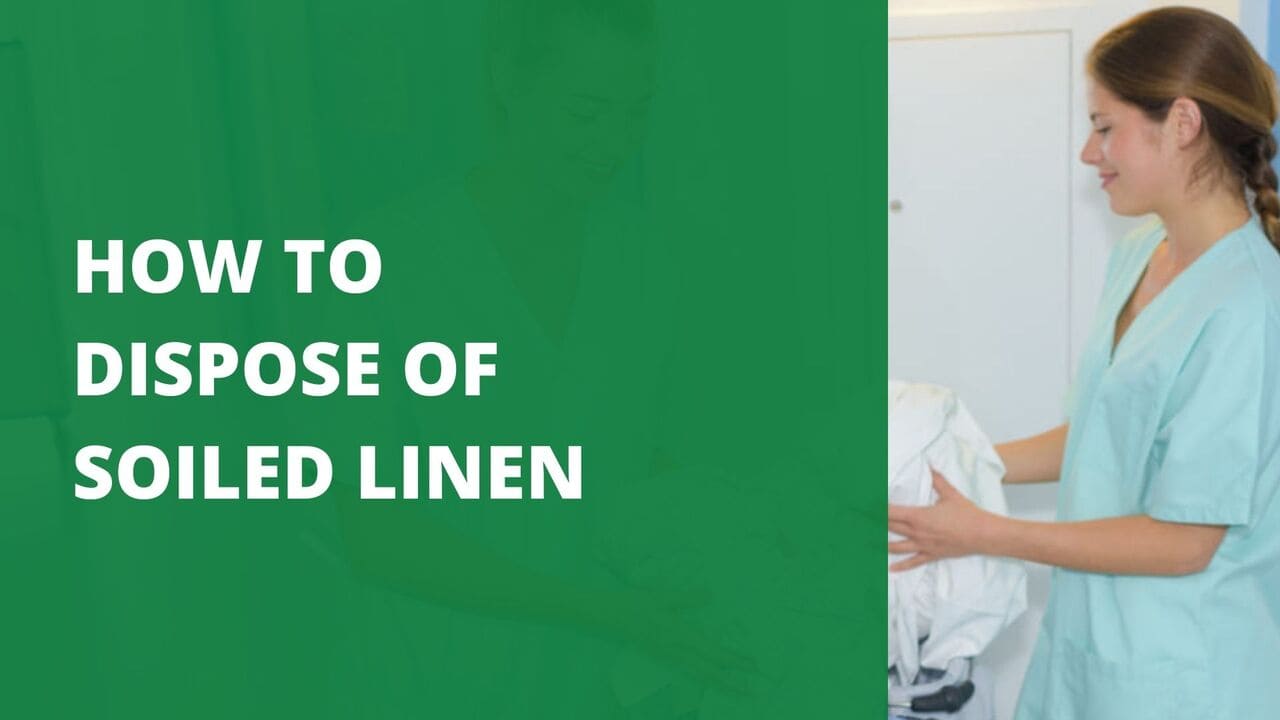As an Amazon Associate I earn from qualifying purchases.
Soiled linen can be a huge hassle for any business. Not only do you have to find a way to get it cleaned, but you also need to figure out how to dispose of it properly. If you’re not sure how to handle this delicate situation, don’t worry – we’re here to help! This blog post will discuss how to dispose of soiled linen and keep your business running smoothly.
If you’re taking care of your home during “spring cleaning,” you might have come across some unsavory items. Specifically, filthy objects that have been crammed in a closet or room that you’ve forgotten about. Soiled linen is a typical garbage item that we all encounter. Whether it’s an old fabric that has been sitting in your closet for years, worn-out linen from use and wear, or soiled linen, it’s important to get rid of them as soon as possible.
What is Soiled Linen?
Soiled linen is any fabric that has been soiled with blood, vomit, urine, or other bodily fluids. This can include sheets, towels, tablecloths, and more. When dealing with soiled linen, it’s important to take extra care to prevent the spread of disease.

Importance of Proper Handling and Disposal of Soiled Linen
Handling and disposing of soiled linen should be taken seriously as it can spread infectious diseases. This includes viruses, bacteria, fungi, and parasites that can cause serious harm to human health. Soiled linen must be handled and disposed of to minimize the risk of infection to others.
How to Dispose of Soiled Linen
Here are some guidelines on how to get rid of soiled linens in your house or if you’re looking after someone who has done so.
1. Wash it on the hot cycle
If the linen is machine-washable, you can dispose of it by washing it on the hottest cycle possible. This will help kill any bacteria that may be present in the fabric.
2. Sanitize it with bleach
Another option is to sanitize the linen with bleach. This is a strong chemical that can kill many bacteria and viruses. Be sure to follow the instructions on the label carefully, as too much bleach can damage the fabric.
3. Throw it away in a sealed bag
The final option is to throw away the soiled linen in a sealed garbage bag. This will prevent any further spread of disease and keep your home clean.
4. Laundry service
If you have a lot of soiled linen or don’t have the time to wash it yourself, you can always use a laundry service. This is a great option for businesses that generate a lot of soiled linen, such as hotels or restaurants.
5. Incineration
Soiled linen that is contaminated with infectious materials or cannot be cleaned should be incinerated. Incineration is a process of burning waste materials, the most effective method of destroying pathogens.
It is important to follow local regulations and guidelines when disposing of linen through incineration.
6. Donate it
If the linen is in good condition, you can always donate it to a local charity or thrift store. This is a great way to get rid of unwanted items and help those in need.
7. Autoclaving
Autoclaving is a sterilization process involving exposing materials to high-pressure steam. It is a suitable method for the disposal of soiled linen contaminated with infectious materials.
However, it is essential to note that this method is only ideal for some types of linen, and it is necessary to follow local regulations and guidelines when using this method.
Fun and Creative Ways to Dispose of Soiled Linen
Okay, there must be more fun and creativity about disposing of soiled linen. It is one of the most mundane and unexciting tasks out there. However, that does not mean we can’t inject a little humor into the situation.
For example, you could try playing a “Soiled Linen Basketball” game and see who can toss their dirty linens into the hamper from the furthest distance. Or, turn the task into a race and see who can bag up their linens the fastest.
All joking aside, when it comes to disposing of soiled linen, it is essential to take the task seriously and do it properly to avoid any potential health hazards or pest infestations. So, while it may not be the most exciting chore on your to-do list, it is essential.
Regulations to Follow
It is important to follow regulations when disposing of soiled linen. In the United States, the Centers for Disease Control and Prevention (CDC) has provided guidelines on safely handling and disposing of dirty linen.
These guidelines recommend placing soiled linen in a leak-proof bag labeled as contaminated. The linen should then be transported to the laundry facility to prevent contamination of other surfaces.
The Dangers of Not Properly Disposing of Soiled Linen
While it may seem harmless to toss your soiled linens into a pile or hamper, the truth is that improperly disposing of them can have severe consequences. Leaving soiled linens open can attract unwanted pests, such as bedbugs or mice. Additionally, if the linens are contaminated with harmful bacteria or viruses, they can pose a severe health risk to anyone who comes into contact with them.
So, what’s the solution? Properly disposing of soiled linens, of course! By taking the time to bag and dispose of your dirty linens properly, you will keep your space clean and pest-free and prevent the spread of harmful germs and bacteria.
Social Care Workers, Follow the Right Protocol
If you work in social care, nursing home care, or any other field where soiled linen is handled regularly, protecting yourself from disease and harm is essential. Ensure you wear the appropriate personal protective equipment (PPE) while getting rid of any linen to avoid contracting illnesses.
When disposing of soiled linens, be sure you’re following your company’s policy. Familiarize yourself with health and safety training, wear PPE, and safeguard your own and others’ health.
Conclusion
As you can see, there are many options for disposing of soiled linen. The best method will depend on the type and amount of fabric you have and your personal preferences. With a little bit of planning, you can keep your home clean and safe from harmful bacteria. Thanks for reading!
FAQs
How often should I dispose of soiled linen?
The frequency will depend on how often the linen is used. If it’s heavily soiled, you may need to dispose of it more frequently.
Can I throw soiled linen in the trash?
Yes, but be sure to seal it in a garbage bag first. This will prevent any further spread of disease.
What if I don’t have time to wash the linen myself?
You can always use a laundry service. This is a great option for businesses that generate a lot of soiled linen, such as hotels or restaurants.
Is soiled laundry a hazardous substance?
In some cases, yes. If the fabric is contaminated with a hazardous substance, such as blood or vomit, it may be considered medical waste. Check with your local government or health department to be sure.
How to Handle Contaminated Linen?
Before putting on gloves, wash your hands. Treat all linen as if it were infected. Folding the linen in on itself when removing bedding from the bed reduces the risk of spreading stains.
To the laundry with you! Don’t shake or drop the linens outside of your body.
Transport of Soiled Linen
Soiled linen should be bagged at the site where it was utilized, and the collection bag must be of sufficient quality to contain the wet/soiled linens and prevent leakage throughout handling and transportation.
Linens must be carried in labeled or color-coded bags or containers according to OSHA regulations.
Soiled Linens as Medical Waste
In some cases, soiled linen may be considered medical waste. This is usually when the fabric is contaminated with a hazardous substance, such as blood or vomit.
If you’re not sure whether or not your soiled linen is considered medical waste, it’s best to check with your local government or health department. Proper disposal of soiled linen is important for both public health and safety.
Do you put detergent in first or clothes?
When putting detergent in the washing machine, pour it into the dispenser or directly into the tub before adding clothes. Following the instructions on the packaging for the correct amount of detergent is also essential.
And if you have a High-Efficiency (HE) washer, use HE detergent to avoid suds and ensure proper cleaning.
Additional Contents
- How to Dispose of Medicines at Home [A Quick Guide]
- How to Dispose of Bamboo Products [A Complete Guide]
- How to Dispose of Corrugated Asbestos Sheets
- How to Dispose of a Plastic Car Bumper (A Quick Guide)
- How to Dispose of Starch Packing Peanuts (A Complete Guide)
Amazon and the Amazon logo are trademarks of Amazon.com, Inc, or its affiliates.


